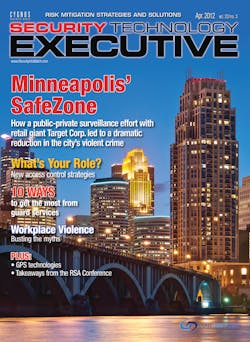As urban centers go, Minneapolis doesn’t leap to mind as one of the nation’s high-crime cities. But when Minneapolis-based Target Corporation decided in the early 2000s to explore the possibility of building more stores in downtown areas, including its home base, it knew that customers wouldn’t visit the new stores unless they felt safe.
“Quite frankly, what we looked at was for our Target shopping experience; the guest demographic we seek is very much a woman with children,” says Brad Brekke, Target’s vice president of assets protection. “They value safety, whether parking their car or coming in to shop without much concern.
“In fact, we try to create a shopping experience that’s not just commodity exchange, but a pleasurable experience,” Brekke continues. “The guest experience, as we call it, is a very big contrast in that we want to be a lot more like Disney World and a lot less like a flea market.”
Like many downtown areas, Minneapolis shares concerns about rising crime rates. “Crime was a challenge downtown,” Minneapolis Police Department Deputy Chief Rob Allen says of the early 2000s. “We have 165,000 at a time coming in to work downtown on a daily basis, and our population of the downtown area in terms of residents grew from about 19,000 to close to 35,000 in less than a decade. There are 65,000 parking spaces. We now have three major sports venues downtown and three professional sports teams.”
From those concerns sprang a public-private effort, now known as the Minneapolis SafeZone Collaborative, that has made the downtown area a more inviting place to visit and laid to rest some of the concerns suburbanites and others might have had about coming to the city. A key component of SafeZone is an extensive video camera system that, officials believe, has helped to dramatically lower crime in the roughly 40-block area being monitored.
The original SafeZone camera system consisted of 30 cameras in 2006, but a gradual expansion raised the number to 45 in the First Precinct, where the monitoring station resides, and another 100 or so are located in adjacent downtown areas.
Allen, a precinct commander in 2001, was asked by the police chief at that time to put together a strategic plan for addressing downtown crime issues. Fortuitously, a friend of Allen’s who worked for Target was sent about that time to a conference in England. “He heard a police officer from North Hampton, England, talking about how they were integrating a camera system with a radio link and fact-sharing information between businesses on people who might cause trouble,” Allen recalls. “That’s how we identified the sort of thing we wanted to model our whole strategy on.”
The video camera system was kicked off with some $200,000 in seed money from Target Corp., along with advice by the company’s security experts on how to make the best use of the cameras.
For years, Target had used CCTV to monitor its stores. It had gone through different iterations, from analog and eventually to IP, and also gained experience using audio communication devices. Platforms called “investigation centers” served as monitoring posts for multiple stores. For its own use, the company also built video forensic labs. All these innovations served as a precursor for Minneapolis’ system.
Target’s investigation centers helped it establish an operating principle that has carried over to the Minneapolis video system. The centers, says Brekke, “allow us to coordinate activity to use video as a force multiplier — to look at multiple stores at once so that the staffing model by store doesn’t have to be as robust. You have multiple resources you can deploy.”
Minneapolis’ system was the first of numerous public-private initiatives for Target. Brekke estimates his company has been involved with “about 23 or 24 of these around the country, from Hawaii to Compton [Los Angeles] to Columbia Heights, British Columbia — different cities we go in, and they don’t all track exactly like [Minneapolis], but they all have sort of the same premise to use technology as leverage and use that almost to bring people together and create a public-private partnership of sorts.”
From a business standpoint, the partnerships have had results, he says: “It transformed from a crime-control measure to basically, in our terms, almost a business growth driver.”
A True Public-Private Collaboration
When tasked with the job of improving enforcement in downtown Minneapolis, Allen turned to Target’s in-house video security experts.
“I knew nothing about video systems, and it didn’t make sense for me or the police department, which knew nothing about video, to try to develop a video system,” Allen says, “so we worked very closely with Target — which is headquartered downtown and has been a great crime-prevention partner with us — to identify how to build a video system. They have 1,500 stores, and every store has 70 to 90 cameras — that’s a lot of cameras. They understand video systems, so they helped us design the system. Their legal department helped us get the clearances to install cameras.”
Initially, the SafeZone Collaborative formed a 501(c)(3), which evolved into the Downtown Improvement District (DID), where the majority of property owners agreed to be taxed at a slightly higher level. Funds generated mainly have been used for downtown safety and security. Maintenance and expansion of the camera system is sustained through the DID.
The DID is funded primarily by special assessments on property tax invoices of commercial properties. Some exempt properties — including government, certain non-profit and residential parcels — make voluntary contributions.
Inside the Surveillance System
Using crime-mapping software, the Minneapolis Police Department identified prime locations for the cameras based on the number of calls for police assistance. Occasionally, compromises about placement had to be made if power or networking availability was lacking at a certain corner. That was not a major setback: “Downtown, where you don’t have as large a tree covering, you actually can see pretty well a block in each direction,” Allen says.
The camera of choice for the project is the outdoor-ready AXIS Q6032-E PTZ dome network camera, with recording and video management software from Milestone Systems. Cameras are typically positioned on utility poles and buildings. Hold-harmless agreements were sought with building owners to protect the city from lawsuits in the event that inadvertent damage occurred during installation. The process was painstaking: “All those types of things needed to get done, and that can be a little challenging,” Allen says.
The introduction of public video systems often raises civil liberties issues, but the police department’s openness helped stem those worries. “There were concerns about privacy on the front end,” Brekke recalls, “but they were very smart in Minneapolis PD. They set up a monitoring station that anyone from the public or media or whatever could come in and watch the same stuff they were watching, so it had no secrets. They did their monitoring behind a glass wall so anybody could watch what the cops were doing, let alone what they were seeing on the video. Transparency is a good thing.”
Private Security Officers
The video camera network served as a springboard for further downtown security enhancements. Private security officers outnumbered Minneapolis police in the SafeZone by an approximate 13-to-1 ratio in 2006, when Janeé Harteau — now Deputy Chief Harteau — was appointed First Precinct Inspector and worked to formalize the SafeZone Collaborative. To take advantage of that disparity, partnerships were formed with private security firms, and a radio-link program was established that allowed private security officers to have direct communication with police on a common channel.
Security officers communicate with police via a combination of police radios on a dedicated talk group that is cross-patched at the Minneapolis Radio Shop to a shared “direct connect” talk group on a Sprint-Nextel system.
“They can talk to the police directly, and the police can talk to them directly,” Allen says. “Most importantly though, the businesses can talk to each other directly so if there is a problem person for example, they say, ‘Hey, we just kicked a guy out of our store, and he’s headed towards your store.”
That cooperation helped make an arrest in a bank robbery. “Private security downtown maintains literally thousands of cameras,” he says, “and so when we put out a description of the bank robber over the radio system, they are monitoring thousands of cameras. They were able to identify the suspect walking through a skyway several blocks away, and we were able to capture the bank robber.”
Crime Rate Drops
Other collaborative participants include community attorneys, residents, businesses, probation officers and social service providers. The SafeZone won a 2006 IACP Community Policing award. Minneapolis earned another IACP Community Policing Award in 2009 for its Downtown Courtwatch, which focuses on repeat offenders.
“We are in our fifth year of drop in violent crime in the SafeZone," Harteau says. "The ‘perception’ of safety in our downtown has improved significantly from receiving a less than 50 percent safety rating in 2006 to a 91 percent approval and safety rating in 2011.”
Despite its successes, the MPD isn’t standing pat. It’s exploring the use of mobile cameras, and the department is also working through legal complexities to establish another level of security collaboration with the business community.
“If a business owner wants to share their exterior cameras with us so that we can look at conditions on the street, we can dramatically improve the number of feet for the area that our cameras cover,” he says.
Bob Giles is a regular contributor to Security Technology Executive.



